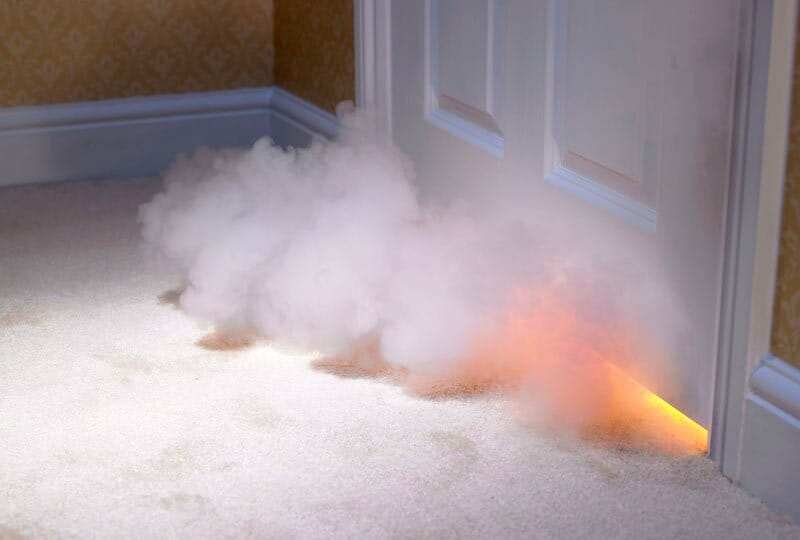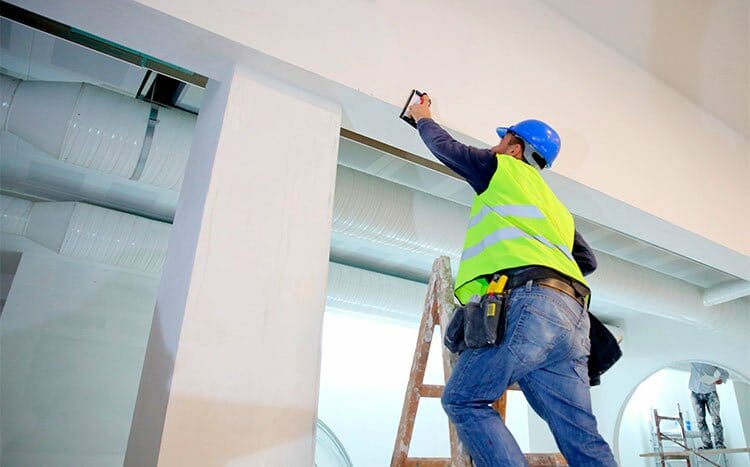Finding ways to slow down the rate at which fire spreads can reduce damage from fires. It can also give individuals more time to safely evacuate. In some cases, it might even enable people to put out the fire before it grows too large to control.
Fire-resistant drywall is the perfect solution for the risks posed by the accidental fire problem. This is because it has been reinforced with glass fibers and other materials to enhance its ability to contain the fire. In most cases, the drywall can withstand fires for more than two hours without crumbling under the heat.
Here is what you should know about fire-resistant drywall and why you need it in your home.
What we cover
ToggleFire-rated drywall
Fire-rated drywall is drywall that has been independently tested and found to be effective at slowing down the spread of fire. This is because the drywall can withstand being exposed to high temperatures without cracking. In most cases, the term is used to refer to Type X drywall.

What is type X drywall?
Type x drywall is drywall that has been reinforced with glass fiber in order to make it fire-resistant. It normally comes in ⅝ inch-thick boards. And it is usually installed in order to retard the spread of fire.
In most cases, it can stop a fire from spreading for up to 60 minutes. This is thanks to its glass fiber reinforcements, ⅝ inch thickness, and the presence of other additives that enhance its ability to resist fire.
Where to install fireproof drywall
Where one should always install fireproof drywall near areas that pose a fire risk. The type of building, or home, in question should also be considered. Here is what you should know.
Residential homes
Generally, building codes and local jurisdictions require the installation of drywall on walls that are near utilities and appliances that can cause a fire. And even in cases where it isn’t mandated by law, prudent homeowners tend to take the initiative to do so. As a result, fireproof drywall is usually installed:
- Near a stove
- Near a Furnace
- Fireplace
Homes that have garages directly attached also tend to have fireproof drywall installed. The drywall is usually installed on the shared walls and ceilings so that the wall can act as an effective retardant in case a fire starts in the garage.
But other than installation near utilities and appliances that pose a fire risk, installation in other areas of the home is rare. This is because residential homes are easy to get out of in case of a fire. And so when weighing the cost of the fireproof drywall against the benefit, most homeowners find it prudent to simply restrict their installation to walls that are near areas that pose a great risk of starting fires.
Multi-family home
In addition to installing drywall near the areas listed above, multi-family homes usually call for additional fireproof drywall installations. This is because these homes have area separation walls. And to slow the risk of catastrophic damage and also lower the risk to life, in case of a fire breaking out in one unit, arming these walls with fireproof drywall is always advisable. Doing will slow down the spread of fire from one unit to the next.
Commercial buildings
For most commercial buildings, installing fireproof drywall in almost all ceilings and building walls is usually mandatory. Building codes usually mandate it especially given that exiting such buildings during a fire breakout tends to be more of a challenge. As such, ensuring that all assemblies and partitions in office buildings have fireproof drywall installations is necessary in order to give occupants a chance to run to safety.
Drywall fire-rating chart
The fire rating that drywall gets usually depends on the type of studs used, the thickness of the drywall, the type of drywall, and the type of joints that one adopts during installation. Whether or not one uses fire tape and overall installation techniques also play a significant role in determining a wall’s fire rating.
| Fire rating | Studs | Drywall |
|---|---|---|
| 1 Hour (non-bearing wall) | 1 Hour (non-bearing wall) | 5/8" Sheetrock “fire core” (Type SCX). No horizontal joints |
| 1 Hour (Bearing wall) | 2” x 4” wood studs | 5/8" Sheetrock “fire core” (Type SCX). No horizontal joints |
| 2 Hour (non-bearing wall) | ‘C’ Shaped 3-5/8" galvanized steel | Two layers of Type X rated 5/8" Sheetrock applied vertically, staggered joints, fire tape on joints. |
| 2 Hour (non-bearing wall) | 2” x 4” wood studs | Two layers of Type X rated 5/8" Sheetrock applied vertically, staggered joints, fire tape on joints. |
Is there 1/2 fire-rated drywall?
Yes, there is because Type C fire-rated drywall also comes in ½-inch thickness. This type of drywall contains more glass fibers than the average fire-rated drywall. It also contains a higher ratio of vermiculite components. And since it is generally superior to Type X drywall, it can get away with being a little thinner without necessarily losing its fire-rated quality.
However, for type X drywall, it typically comes in 5/8 inch boards and not ones that are as thin as ½ inch.
What is 1 hour & 2-hour firewall?
A 1 hour rated firewall is a wall that can retard the spread of fire for at least 60 minutes. That is, when exposed to fire, it can withstand the heat for about an hour before it becomes overwhelmed by the fire.
As for a 2-hour firewall, it is a wall that can keep a fire from spreading for more than 2 hours. This means that it can be exposed to fire for more than 2 hours before it shows any sign of crumbling under the heat.
Can I use type X drywall everywhere?
Even though it is inadvisable, it is possible to use Type X drywall everywhere. It is not prudent to do so mainly because type X drywall is incredibly more expensive than standard drywall. Using it everywhere in a one-family residential home is thus not prudent.
When weighing the decision on whether to install type X drywall everywhere, it is always good to remember that fire-resistant drywall isn’t designed to completely stop a fire in its tracks. It is intended to slow down the rate at which it spreads so as to:
- Limit the extent of the damage that the fire causes
- Give occupants in a home or building enough time to get to safety
Keeping these two things in mind is advisable especially when you consider the fact that fire can always go around walls. It can use doorways, vents, and other pathways that offer less resistance to its spreading. And so installing type x drywall may not have as great a pay-off as you may expect. The added costs of such an undertaking may thus not be justifiable.
How much does fireproof drywall cost?
The cost of fireproof drywall normally depends on the type of drywall, its size, and the thickness of the panel that you are looking to purchase. Generally, they tend to be slightly pricier than regular drywall. And as far as fireproof drywall types are concerned, type X drywall tends to cost slightly less than type C drywall.
| Type | Cost |
|---|---|
| Regular drywall 1/2" | 0.30 to 0.37 per square foot |
| Fire-resistant 1/2" | $0.34 to $0.42 per square foot |

How is fireproof drywall made?
Fireproof drywall is made by increasing the density of the drywall, adding glass fiber and other fire-retarding additives, and then making the drywall thicker — ⅝ -inch thickness is common. The combination of increased thickness and density, in addition to reinforcement from glass fibers, is usually enough to slow down the rate at which fire spreads.
Is there special fire-resistant drywall mud?
No, there isn’t a special fire-resistant drywall mud that you need to use when installing fire-rated drywall. Regular drywall will do just fine mainly because it is not flammable and it is heat resistant to a point where one can safely use a heat gun or a hairdryer to dry it.
At what temperature will drywall ignite?
Drywall will ignite at 450 degrees Fahrenheit and this is mainly because the drywall contains paper. The fact that it is typically covered in paint that is flammable also contributes to its likelihood ignite especially right after exposure to fire.
Use this free service to find a good drywall contractor
If you need help with installing fire-resistant drywall, or if you simply need help with deciding on which drywall to use and where exactly to install it, contacting a good drywall expert is advisable. And the easiest and fastest way of getting in contact with one is by using HomeGardenGuides.com. It offers a free service that quickly matches you with the top-voted local experts.
Using the website, you can get 3 estimates fast by real certified experts in your area in just 2 minutes. Here is how it works.
- You scroll to the top of the page and enter your Zip code.
- Answer questions about your drywall remodeling project
- Your details will be forwarded to three local experts.
- You will then receive a price estimate for the job and some friendly advice.
IMPORTANT: There is no obligation to hire. This is a free tool and service to be used at your pleasure.













